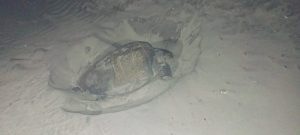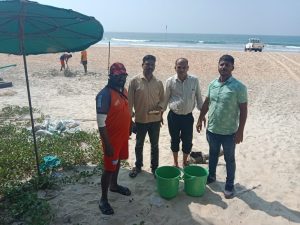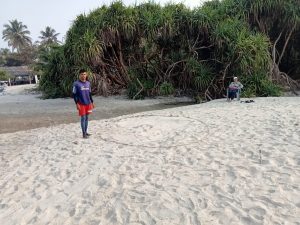


The New Year for Goa appears to have begun with a fresh wave of endangered Olive Ridley turtles landing on the state’s beaches laying more than 100 eggs over the last few weeks.
Only this time, the turtles appear to have unconventionally chosen popular beaches like Vagator, Cavelossim and Arambol, unlike beaches like Galgibaga and Morjim, which are traditionally known for being home to turtle nesting sites.
According to Drishti Marine, its lifesavers and beach safety patrol (BSP) personnel deployed at night to keep vigil on Goa’s beaches discovered over 103 eggs spread across the three beaches. The turtle eggs have been handed over to the Goa government’s Forest Department.
Drishti BSP and lifesavers play an important part in safeguarding the nesting turtles and their egg-laying sites throughout Goa’s 105 km long coastline and are designated first responders and rescuers of distressed marine life. While at Ashwem and Vagator, the turtle eggs were found buried in a nesting area in a more secluded location of the beaches, at Cavelossim an Olive Ridley turtle laid eggs along the regular beach stretch.
“The Drishti ‘Beach Safety Patrol’ is deployed at night across Goa’s beaches to monitor the area. However, in the turtle nesting season , they play another very important role, which is safeguarding nesting turtles who arrive to lay their eggs on beaches where they were born,” says Navin Awasthi, the operations head of Drishti Marine.
“However, due to increasing anthropogenic stressors , sea turtles may be changing their behaviour and heading to other beach stretches. Goa’s six-year-old marine stranding network is a collaborative effort between the State Forest Department under whose guidance and permits, Drishti Marine Lifesaving provides first responder support with coordination with other network member organisations and volunteers provided by Drishti Marine Foundation & Terra Conscious,” he also said.
BSP teams are also tasked with guarding nesting turtles from curious crowds and ensuring they safely nest and head back to their ocean home. These nests are then relocated to designated hatcheries by the Forest Dept to be watched over until the little hatchlings appear and start their journey back to the sea.
Drishti advises people to avoid coming in close proximity of the endangered turtles on the beaches, irrespective of whether they are dead or alive, and to notify the nearest lifesaver or BSP on duty with regards to any turtle sighting.






